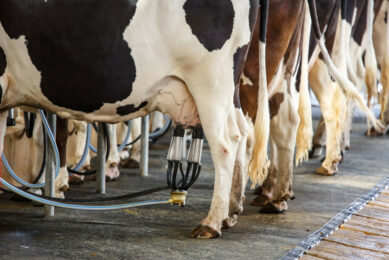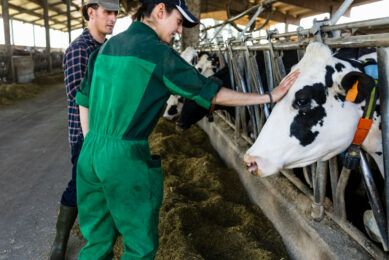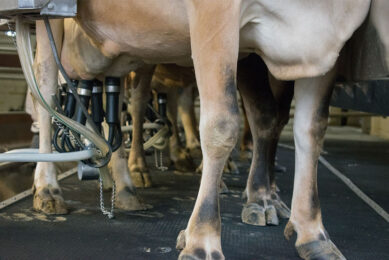The role of cow claw trimming on welfare and profitability
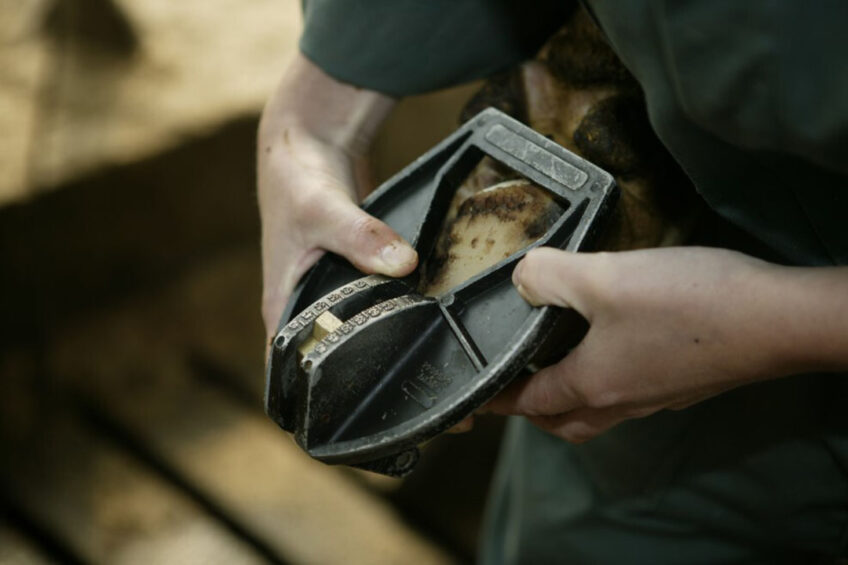
Claw trimming is an essential lameness management procedure that improves claw health by creating appropriate weight distribution between the medial and lateral claws. In addition, claw trimming affects dairy cattle behaviour and milk yield, in turn improving welfare, production performance and profitability.
Lameness is a major production disease affecting dairy cattle health, welfare and profitability. It causes considerable economic losses because of additional labour, repeated treatments, euthanasia, early culling, reduced milk yield, poor reproductive performance and shortened productive years. Therefore, lameness prevention and treatment are important to prevent financial losses and welfare problems.
Lameness is defined as a deviation from the normal gait caused by lesions, diseases and other factors such as genetics, nutrition housing systems and management practices. Lameness is an indicator of poor welfare because it is associated with pain, discomfort, reduced mobility and reduced ability to cope with the environment. After reproductive problems, lameness is one of the most important reasons for the premature culling of breeding females.
Dairy cattle lameness prevalence in the UK is estimated at 36.8%, in Switzerland at 14.8% and in the northeastern United States at 54.8%. Worldwide, cattle lameness prevalence ranges from 14% to 55%. Direct lameness costs include increased workload, medical treatment, culling costs and production costs, as well as decreased milk yield and reduced (re)productive performance. It is estimated that lameness costs the UK dairy industry approximately £128 million/year (US$ 164 million/year).
Claw trimming methods
Different claw trimming methods include the functional claw trimming or Dutch method, the White Line method, the White Line Atlas method and the Kansas method. These methods yield considerable differences in sole thickness and presentation, which affect their preventive or curative purpose.
The Dutch 5-step method or functional claw trimming, proposed by Toussaint Raven, is widely applied in the dairy industry. In this method, the outer and inner walls of the claw are levelled, and they are presented perpendicular to the metatarsals. The White Line method, developed by Blowey, is based on examining the sole thickness during trimming until the white line becomes visible at the toe region to ensure that weight bearing between the lateral and medial hind claws is equal.
The White Line Atlas method, described by Vic Daniel and Randall White, applies four major landmarks or biomarkers – the white line or pressure line, normal sole thickness, claw length/angle and heel fulcrum – to ensure proper claw trimming. The Kansas method is developed based on the variations in wall length, heel depth, sole thickness and sole gradient between animals. This method results in the inner wall being lower than the outer wall and presentation of a natural sole angle.
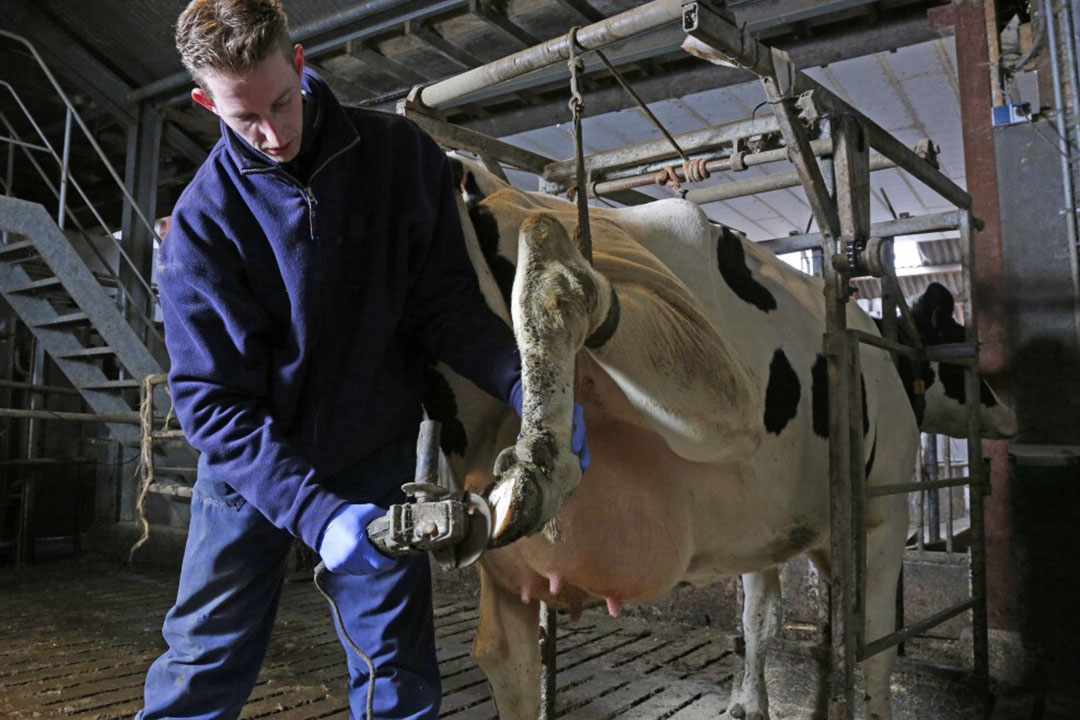
Corrective vs preventive
Corrective claw trimming is conducted to control infectious claw lesions, such as digital dermatitis, by removing loose and damaged claw horn tissue and modifying the interdigital cleft to decrease exposure to manure slurry. On the other hand, preventive claw trimming is performed to correct claw horn overgrowth, thereby re-establishing appropriate distribution of the cow’s bodyweight within and between the claws of each foot. In addition, preventive claw trimming reduces the likelihood of lameness during the high-risk periods such as lactation.
Claw heath and production
Claw overgrowth occurs when horn production happens at a faster rate than it wears, which affects the weight bearing within and between the claws. Claw trimming is used to correct claw overgrowth and alterations in weight bearing by reducing the dorsal wall length and creating uniformity in sole thickness of each claw, which, in turn, reduces lameness prevalence.
Claw trimming is also performed to mitigate the pain associated with sole ulcer, sole haemorrhage, white line disease and toe ulcers, by removing the affected horn while preserving the healthy parts. Furthermore, claw trimming on farms endemic for digital dermatitis lowers the prevalence of sole ulcer, sole haemorrhage, white line disease, toe ulcers and double sole during lactation by restoring a proper claw angle, heel height and weight bearing.
It is notable that long intervals between trimmings are associated with higher prevalence of digital dermatitis. Milk yield decreases significantly in the short term after claw trimming due to the stress-related changes in dairy cows following the claw-trimming procedure, especially in the absence of pain management. However, different studies have reported significant increases in long-term milk yield after claw trimming, which is due to amended locomotion score, improved behavioural activity linked to production, as well as physiological response to alleviate stress in the affected animals.
Frequency of claw trimming
The highest frequency of lameness is usually between the second and fifth months of lactation; therefore, preventive claw trimming at dry-off and again at days in milk 40 to 60 decreases lameness prevalence during this period. Furthermore, claw trimming before dry-off results in lower odds of lameness and reduced risk of sole ulcers in the subsequent lactation. Several studies showed lower levels of sole ulcer, sole haemorrhage, white line disease and toe ulcers in farms where cows underwent preventive claw trimming twice during lactation compared to farms where the practice was once per lactation.
Conclusion
Lameness is a multifactorial condition affecting the health and welfare in dairy cattle. The lack of appropriate functional claw trimming is one of the most common causes of lameness. Functional claw trimming restores the physiological shape of the claws and distributes weight properly between the claws and over the claw weight-bearing surface. In addition, claw trimming allows closer examination of the claws for early signs of lameness.
However, it is important not to overtrim the claws and to keep trimming tools clean. Furthermore, it is critical to identify the appropriate timing and claw trimming technique that results in greater reduction in claw lesions under various management systems.



